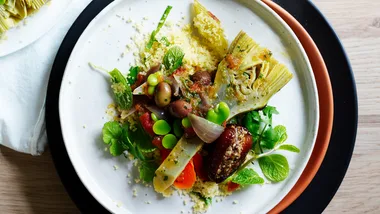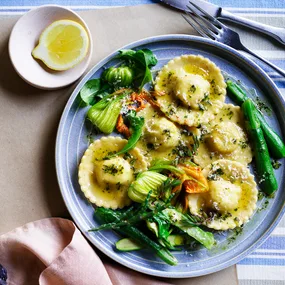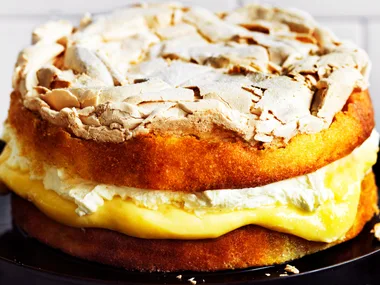“During lockdown people couldn’t go to restaurants, so we came up with this lobster ravioli as a way for people to treat themselves,” says Andrea Vignali of Melbourne’s Al Dente. While Al Dente uses lobster, we’ve substituted king prawns in this recipe.
Ingredients
Filling
Bisque
Method
1.Make pasta dough and sheets (see [Al Dente’s pasta dough recipe](https://gt.staging.digital.aremedia.com.au/recipes/chefs-recipes/pasta-dough-egg-yolk-semolina-19349|target=”_blank”)).
2.For filling, heat olive oil in a large frying pan over medium heat. Add onion and garlic and cook until softened (5 minutes). Deglaze with wine and reduce by three-quarters (2 minutes). Remove from heat, then add ricotta, basil and orange zest and whisk until combined. Transfer to a large bowl and cool slightly. Add prawn meat and toss to combine and season to taste.
3.For bisque, heat oil in a large saucepan over high heat. Add onion, garlic, herbs, carrot, parsnip, chilli and apple and cook, stirring occasionally, until slightly softened (10 minutes). Add reserved prawn shells and heads and cook, stirring occasionally, until there is no more liquid and everything begins to caramelise (5 minutes). Add tomato paste, and let it colour without burning (3 minutes). Once it starts to dry and bubble, add white wine and reduce by half (10 minutes). Add 4 litres water and bring to the boil. Reduce heat to medium and simmer for 1 hour skimming any impurities that rise to the surface. Strain through a fine sieve into a large saucepan. Place pan over medium-high heat and reduce by three-quarters or until sauce has thickened (1 hour). Add lemon juice and orange and lemon zest to balance the flavours. Season to taste. Keep warm and set aside.
4.To make ravioli, working with one sheet of pasta at a time, place sheet on a lightly floured work bench and pipe approximately 2 tbsp (30gm) filling onto sheet about 6 centimetres apart. Brush around filling lightly with water and top with another sheet of pasta. Press edges to seal, ensuring no air is trapped inside the pockets and trying to maintain an even layer of the filling in the centre of the ravioli. Then, using a 6cm-circle cutter, line up the filling, placing the cutter upside down (blunt side), and gently slide and press around edges to shape filling. Repeat with each ravioli. Using an 8cm-fluted cutter, cut out each ravioli, leaving a 1cm border around the filling. Press down firmly along the edge of each individual ravioli. Makes 18.
5.To cook ravioli, fill a large saucepan three-quarters full with salted water and bring to the boil over high heat. Add pasta, in batches if necessary, and return to the boil (the pasta water should be rolling not rapidly boiling; adjust heat as necessary). Cook, stirring gently, until pasta is cooked (3-4 minutes).
6.Meanwhile, heat bisque over medium heat until hot (3-4 minutes). Drain pasta, and transfer to a large heatproof bowl. Add 165ml bisque, season to taste and toss gently to combine. Divide ravioli among plates, spoon over remaining bisque and scatter with nasturtium leaves and chilli flakes.
Leftover bisque can be frozen in an airtight container for later use.
Notes









